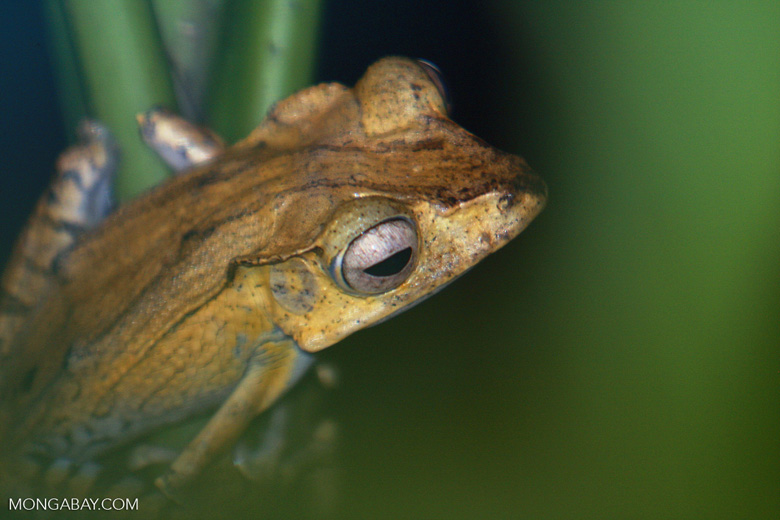- Globally, more than 40 percent of amphibians are threatened with extinction.
- Researchers found palm oil plantations harbor many fewer species than primary forest, or even logged forests.
- They say preserving and restoring riparian forests in palm oil plantations could significantly improve amphibian biodiversity — but it would still be no match for primary forest.
A new study published this week in Biotropica finds palm oil is taking heavy tolls on amphibian biodiversity, with plantations harboring many fewer species than even logged forests in the same areas. But its authors say this could be turned around to some extent if plantations simply keep their riverbanks forested.
Palm oil plantations are rife in many parts of Southeast Asia, with Indonesia and Malaysia bearing the brunt of production. As global demand for palm oil increases, production has risen apace, increasing by 20 percent just from 2010 to 2014, according to the U.S. Department of Agriculture. These plantations are established often at the sake of natural forest, and their proliferation has led to widespread deforestation. While Southeast Asia is still the epicenter of palm oil production, the industry is gaining momentum in tropical areas around the world, with land limitations in Indonesia and Malaysia spurring oil palm plantation expansion in Africa, South America, and India.
As forests are cleared to make way for plantations, the animals that once called them home often must move or perish. Amphibians are particularly affected by changes in their environment. Many are even used by scientists as “indicator species” when assessing habitat damage. Their semipermeable skin, inability to travel long distances, and sensitivity to temperature and humidity changes means that they may be affected by habitat alteration that mammals and birds are more able to weather.
“Because of their high habitat specificity and exposure to diseases, the extinction risk of these amphibians is probably underestimated,” the researchers write in their study.
Their findings come at time when estimates peg more than 40 percent of the world’s 6,400-some amphibian species as threatened with extinction. Habitat destruction, climate change, and disease are considered the main drivers of this “amphibian crisis.”


To figure out just how amphibians may be affected by oil palm plantation development, the researchers – who hail from institutions in Germans and Brunei – surveyed plantations, logged forest, and primary forest for stream-dependent frogs in the Malaysian state of Sabah on the island of Borneo. They recorded a total of 5,549 individual frogs belonging to 43 species. As expected, they observed the greatest diversity – 37 species – in primary forest. Next up was logged forest, with a total of 28 species. Palm oil plantations brought up the rear, with just 19 total frog species recorded in their streams.
In other words, the team found only half as many frog species in palm oil plantations than in primary forest. Notably, six of the 19 species found there were observed in plantation streams and not in primary forest, meaning that only 13 of the primary forest species – or 34 percent – were recorded in plantations.
“Our findings on the effect of land conversion in Southeast Asia on frog species richness, density, and community composition have important implications for anuran conservation and the design of oil palm plantations,” the authors write. “Primary forests and logged forests were similar in species richness and community composition, whereas oil palm plantations did not provide suitable habitat for two-thirds of the original forest species.”
But what about the frogs the researchers found in plantations but not in primary forest? They surmise this may be due to the habitat differences between the two environments: plantations provide a flat area where water collects in places like ditches, ponds, and drainages, which some frog species may like. Those species may have a harder go of it in the mountainous rainforest the team surveyed, where water is soaked up by vegetation or swiftly channeled to streams.
However, while plantation life may suit a few generalist species, most seem to prefer real forest. “In particular, the hilly lowland rain forest in Borneo is a diversity hotspot for [frogs],” the authors write.

The researchers say their findings highlight the importance of tree canopy cover for stream-living amphibians. Even in plantations, they found significantly more frog species in streams whose banks had been left forested than in those without. They suggest this is because forests help protect rivers in a variety of ways, from reducing soil erosion into the water to connecting habitats and populations.
The team recommends preservation and restoration of riverbank forests as a way for oil palm plantations to improve amphibian biodiversity – with the caveat that even this can’t compare to the value of original habitat.
“The oil palm industrial monoculture is a primary forest frog’s worst nightmare but could be mitigated in part by rigorously enforcing the creation of riparian buffer zones within plantations,” Dr. Oliver Konopik, lead author of the study. “Frogs play a central role in the forest food web and thus need to be protected.”
Citation:
- Konopik, O., Steffan‐Dewenter, I., & Grafe, T. U. (2015). Effects of Logging and Oil Palm Expansion on Stream Frog Communities on Borneo, Southeast Asia. Biotropica, 47(5), 636-643.













